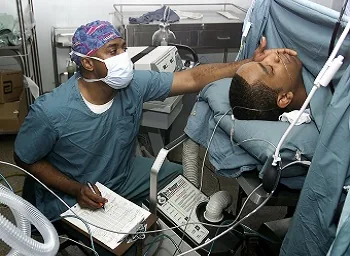New Traumatic Brain Injury Guidelines
New Traumatic Brain Injury Guidelines. A traumatic brain injury is one of the most severe injuries that someone could sustain. There are many different potential causes of traumatic brain injuries which include:
- Slip and fall injuries
- A fall from a great height
- A motor vehicle accident such as a motorcycle, truck, or auto accident
- An assault
- A traumatic brain injury sustained during sports, such as a concussion
Regardless of the mechanism of the traumatic brain injury, these are serious events which must always be examined in detail by a doctor. Some of these injuries could even lead to lifelong complications. Some statistics on traumatic brain injuries published by the American Academy of Neurological Surgeons (AANS)include:
- The total annual costs of traumatic brain injuries in the United States total around $50 billion every year.
- Close to 250,000 people are required to spend time in the hospital every year for a traumatic brain injury.
- This is more than 20 times the total number of hospital stays annually for an injury of the spine.
- Traumatic brain injuries are among the leading causes of death in children.
- Males sustain traumatic brain injuries at about four times the rate of females.
Traumatic brain injuries have a serious impact on countless families all over the country every year. Because of this, it is important to have well-established guidelines so that everyone, including medical professionals, knows what to do if someone sustains a traumatic brain injury.
An Overview: New Guidelines from Trained Professionals
A team of trained medical professionals from all over North America recently came together to develop new guidelines for the evaluation and treatment of traumatic brain injuries. This is important because many hospitals have policies in place. However, these policies can be different and might lead to different outcomes in different locations. Therefore, it is crucial for hospitals to work together and decide on the most appropriate course of action. The steps in this development include:
- A survey of trained medical professionals to determine whether they would be open to new guidelines.
- The results of the study indicated that physicians felt that they would be open to new guidelines.
- An evaluation of the outcomes of traumatic brain injuries, stratified by severity, based on their treatment.
- Additional guidelines for the follow-up and rehabilitation of traumatic brain injuries.
The researchers and medical professionals developed dozens of guidelines and proposed other recommendations for a holistic approach to treating traumatic brain injuries. Some of these include:
- Developing a collaborative approach between neurologists, neurological surgeons, orthopedic surgeons, and pediatric or adult ICU care.
- Guidelines regarding both the frequency and severity of interventions for traumatic brain injuries.
- Minimizing sleep disturbances following a traumatic brain injury.
- The potential for behavioral and personality changes to develop and how to reduce these risks.
- Managing fatigue and cognitive disturbances following a traumatic brain injury.
- Ensuring the early intervention of physical and occupational therapy.
- The importance of social interaction.
- The managing of increasing intracranial pressure.
- Minimizing blood loss in the operating room.
- Prophylaxis of potential infections that could develop.
- Early social and community interaction in the rehabilitation process.
Ultimately, while these guidelines are important for the medical treatment of traumatic brain injuries, there are additional impacts of neurological damage that must be addressed. These can have significant implications for the well-being of a family, and cannot be overlooked.
The Impact of Traumatic Brain Injuries on Families
When a loved one has been diagnosed with a traumatic brain injury, it can be difficult for families to cope. There are many issues that arise following a serious injury, including:
- The emotional impact of dealing with a chronic medical condition.
- Questions surrounding the uncertainty of the future.
- Trying to cope with potential disabilities that could result from a traumatic accident.
- Concerns about the overall prognosis of a brain injury.
- Possible rehabilitation, the logistics of having a loved one in a hospital, and the impact that this might have on relationships with family and friends.
In particular, while the motor and sensory deficits from a traumatic brain injury are significant, neurological damage can also have impacts on someone’s personality. It is important for families dealing with a traumatic brain injury to take a comprehensive approach to the treatment of neurological damage. There are additional resources available which could be helpful.
Related Articles
Sacramento Traumatic Brain Injury Lawyers
I’m Ed Smith, a Sacramento Traumatic Brain Injury Lawyer. Traumatic brain injuries are serious, and guidelines are in place. If you or a loved one has suffered injuries in a car accident, call me at (916) 921-6400 or (800) 404-5400 for free, friendly legal advice.
I am a member of the Million Dollar Advocates Forum.
You can go to our verdicts or settlements page to see how we’ve resolved our past cases.
See our client reviews on Yelp, Avvo, & Google.
New Traumatic Brain Injury Guidelines: AutoAccident.com
Image Attribution: The photo at the start of this article is seen in its original form on Unsplash. The image has been reproduced here with permission/ New Traumatic Brain Injury Guidelines.
:dr cha [cs 863] cv

